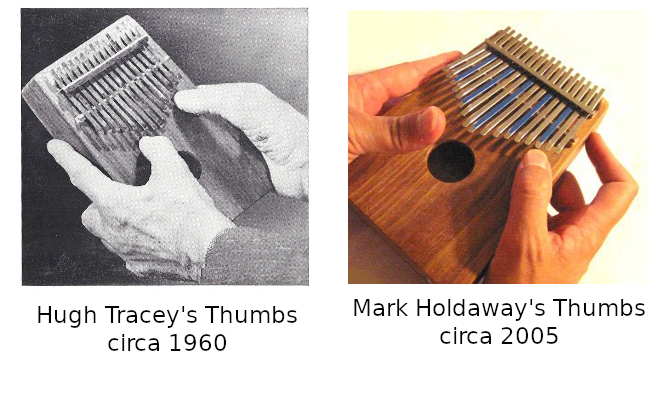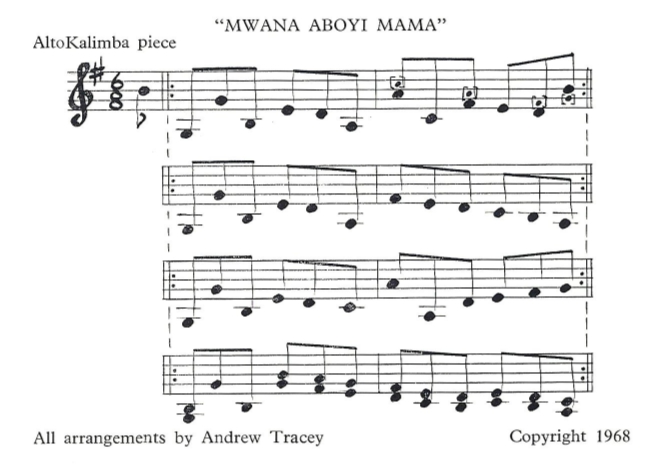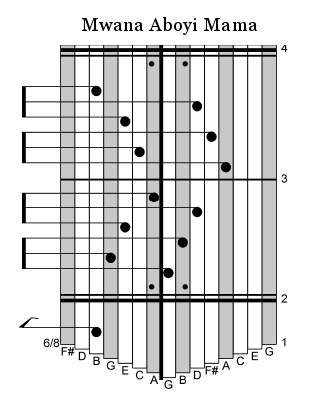
Use of this website constitutes acceptance of the Privacy Policy and User Agreement. Copyright © 2020 Kalimba Magic. All Rights Reserved.
When Hugh Tracey made his new kalimbas back in 1954, there were only a few people in the world who could play this non-traditional African instrument.
But what about people in Africa? Didn’t they too play kalimba? They did, but they played instruments with other designs, other setups, and other tunings. The Hugh Tracey Kalimba was a new instrument in the kalimba family, ideally suited to playing western music.
Hugh’s eldest son Andrew Tracey went to Oxford to study music so he could write a manual for the Hugh Tracey kalimbas. This old 1968 manual is hard to find, so I scanned it and make it available to you (with AMI permission, of course).

Hugh Tracey, the person who started making commercial kalimbas in South Africa in the 1950s, used to play J.S. Bach’s “Jesu, Joy of Man’s Desiring” on the Treble Kalimba to promote the new instrument.
But there was a huge gulf between what The Traceys – Hugh and sons Andrew and Paul – could do on the instrument and what the rest of the world could do. The solution to this problem was for Hugh and Andrew to write the 1968 kalimba instructional manual. You can read some words Andrew spoke about writing the 1968 manual. Back then, this manual came for free with every Hugh Tracey Kalimba. Some time in the 1970s AMI stopped shipping each kalimba with the manual. But you can download the 1968 manual for free now here.
 Some people who can read music will find that the 1968 manual is exactly what they need. Here is an example from the manual, an African song for the Alto kalimba:
Some people who can read music will find that the 1968 manual is exactly what they need. Here is an example from the manual, an African song for the Alto kalimba:

However, in my mind, the staff notation for kalimba is nonoptimal, because you cannot tell immediately which thumb will play each note, i.e., both the left and right thumb parts are listed on the same staff. Also, I get slowed down by the staff notation running across the page, while the kalimba itself is rotated 90 degrees to the conventional staff notation.
 So, I invented a different way of displaying kalimba music: kalimba tablature. Basically, the tablature is a stretched out map of the kalimba, showing you which tines to play to make a melody or harmony.
So, I invented a different way of displaying kalimba music: kalimba tablature. Basically, the tablature is a stretched out map of the kalimba, showing you which tines to play to make a melody or harmony.
I have seen many people, and have heard from many more, who, without musical experience, can pick up a kalimba and read the simple kalimba tablature and make music right away.
Kalimba Magic offers dozens of tablature-based books and ebooks, which I assert are an easier, more natural way for most people to learn to play kalimba.

Oh! And if you are getting one of my books or ebooks, remember to use the coupon code BOOK30 to get 30% off of all of our books and ebooks.


Sign up for our newsletter and free resources with your email address:
We pinky promise not to spam you and to only send good stuff.
 Assist Paul Tracey Rebuild His House in Pacific Palisades
Assist Paul Tracey Rebuild His House in Pacific Palisades 8-Note Spiral Kalimba Turned into a Student Karimba
8-Note Spiral Kalimba Turned into a Student Karimba Seek to Infuse Your Musical Moments With Beauty and Magic
Seek to Infuse Your Musical Moments With Beauty and MagicUse of this website constitutes acceptance of the Privacy Policy and User Agreement. Copyright © 2020 Kalimba Magic. All Rights Reserved.